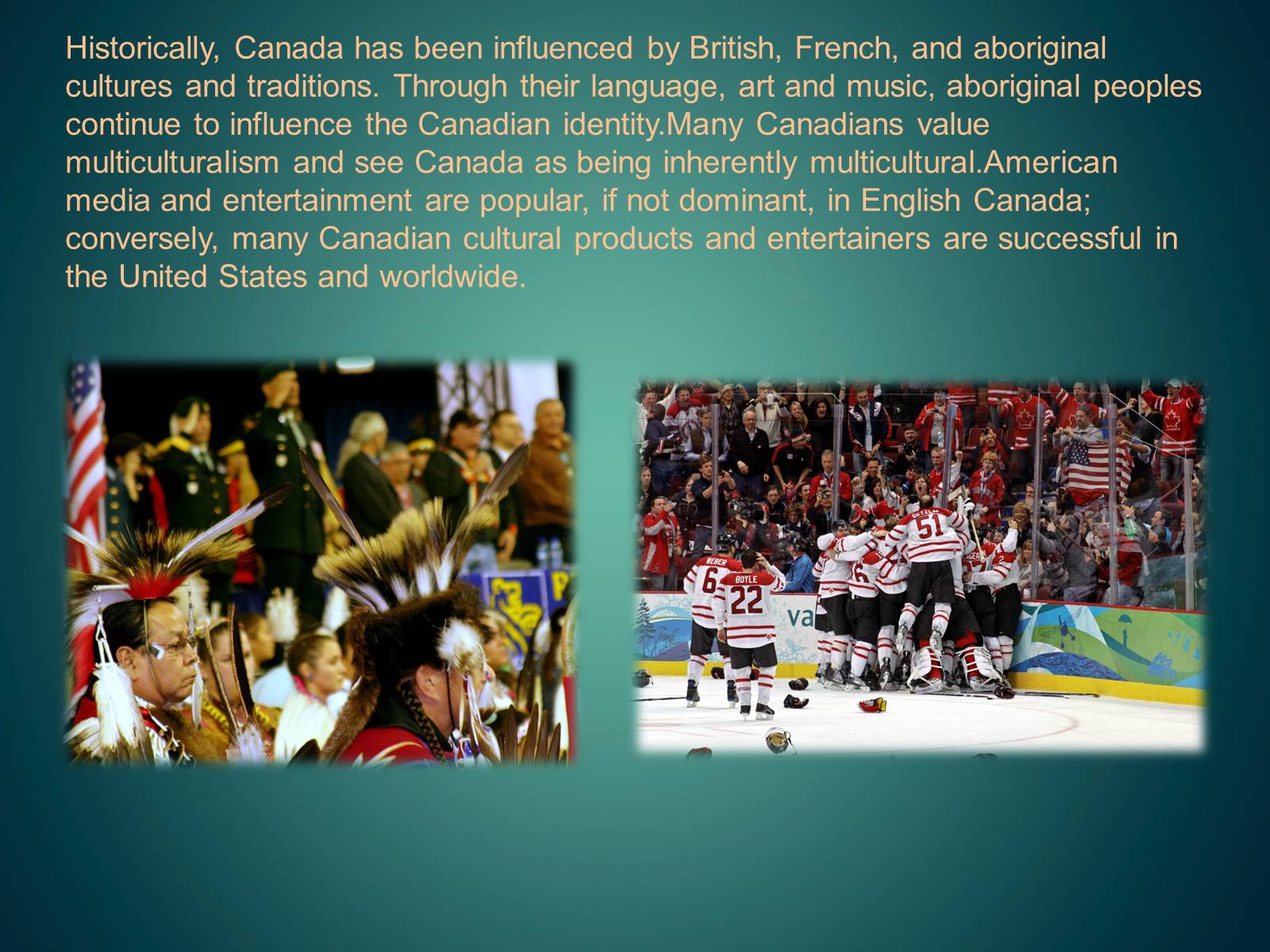- Головна
- Готові шкільні презентації
- Презентація на тему «Canada» (варіант 6)
Презентація на тему «Canada» (варіант 6)
158
Слайд #1
Презентаціяз предмету “Країнознавство”
На тему :
«Канада»учениці 6(10)-В класуОдеської гімназії №5Закар'ян Каріни
На тему :
«Канада»учениці 6(10)-В класуОдеської гімназії №5Закар'ян Каріни
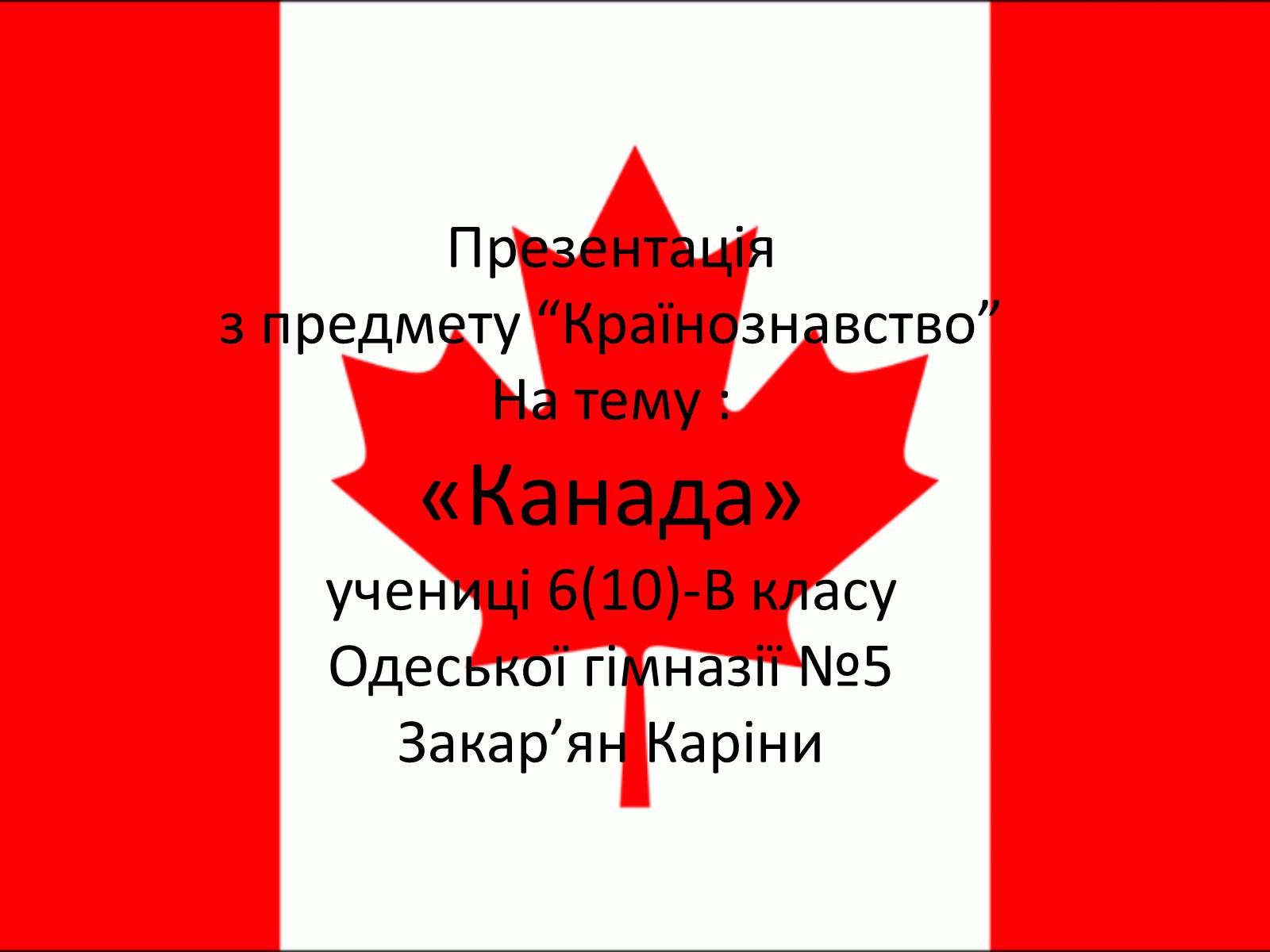
Слайд #2
Canada is a country in North America consisting of 10 provinces and 3 territories. Located in the northern part of the continent, it extends from the Atlantic to the Pacific and northward into the Arctic Ocean. At 9.98 million square kilometres in total, Canada is the world's second-largest country by total area, and its common border with the United States is the world's longest land border shared by the same two countries.
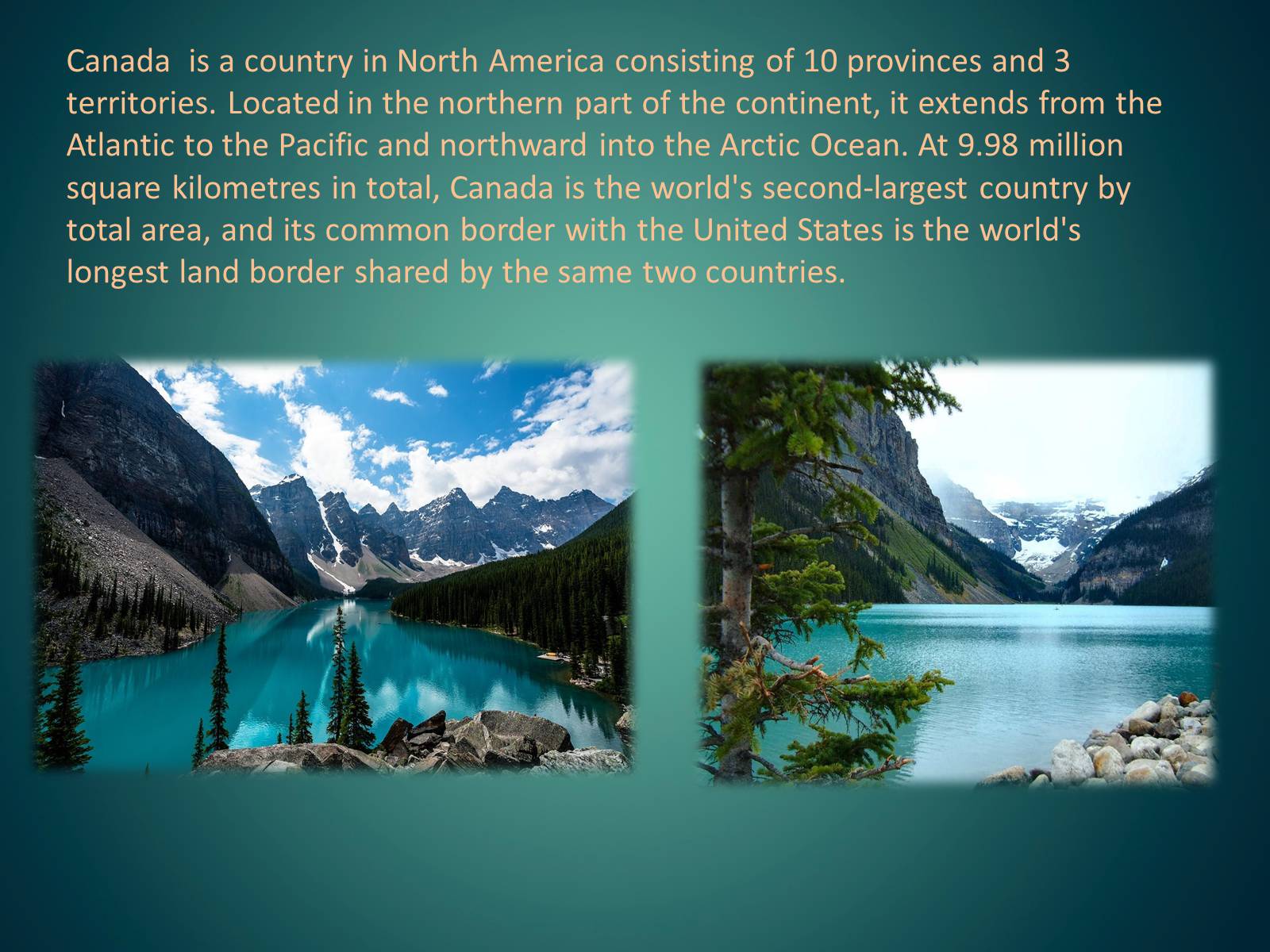
Слайд #3
The land that is now Canada has been inhabited for millennia by various Aboriginal peoples. Beginning in the late 15th century, British and French colonies established on the region's Atlantic coast. As a consequence of various conflicts, the United Kingdom gained and lost North American territories until left in the late 18th century with what mostly comprises Canada today. Pursuant to the British North America Act, on July 1, 1867 three colonies joined to form the autonomous federal dominion of Canada. In 1931 Britain granted Canada full independence in most matters with the Statute of Westminster 1931. The last ties were dissolved in 1982 with the Canada Act 1982.
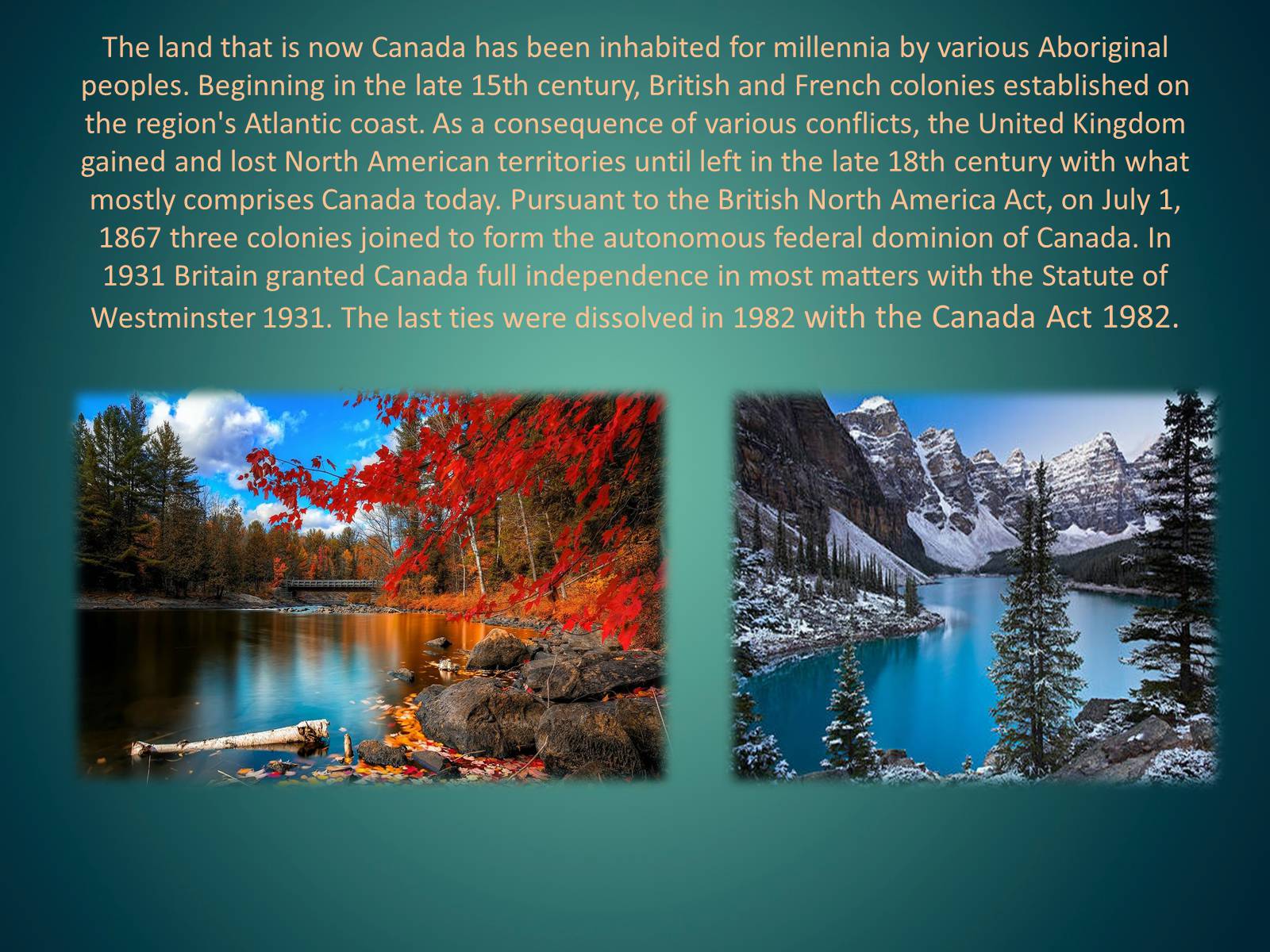
Слайд #4
Geography
Canada occupies a major northern portion of North America, sharing land borders with the contiguous United States to the south (the longest border between two countries in the world) and the US state of Alaska to the northwest. Canada stretches from the Atlantic Ocean in the east to the Pacific Ocean in the west; to the north lies the Arctic By total area (including its waters), Canada is the second-largest country in the world, after Russia. By land area alone, Canada ranks fourth.
Canada occupies a major northern portion of North America, sharing land borders with the contiguous United States to the south (the longest border between two countries in the world) and the US state of Alaska to the northwest. Canada stretches from the Atlantic Ocean in the east to the Pacific Ocean in the west; to the north lies the Arctic By total area (including its waters), Canada is the second-largest country in the world, after Russia. By land area alone, Canada ranks fourth.
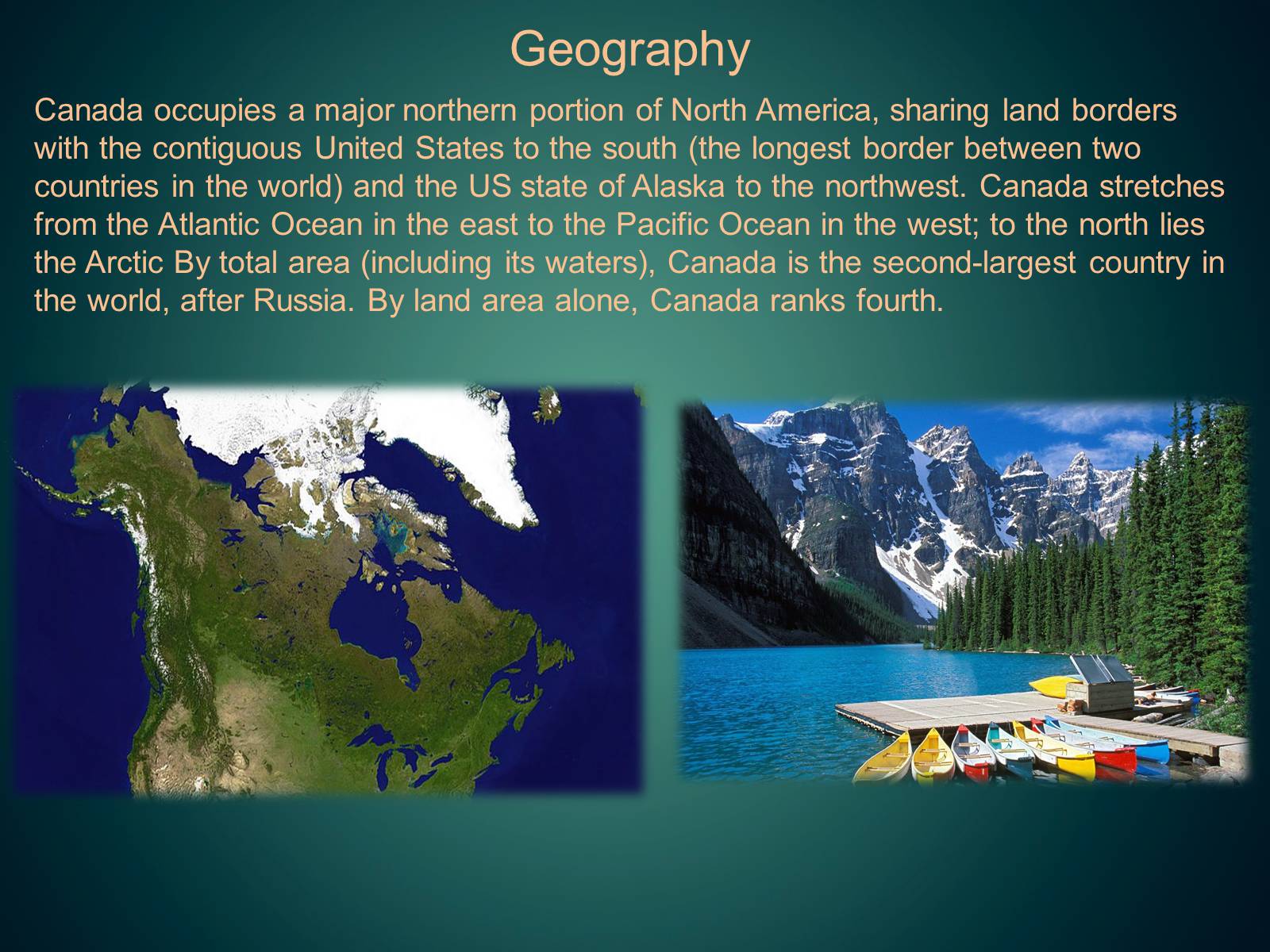
Слайд #5
Government and politics
Canada has a parliamentary system within the context of a constitutional monarchy, the monarchy of Canada being the foundation of the executive, legislative, and judicial branches.The sovereign is Queen Elizabeth II, who also serves as head of state of 15 other Commonwealth countries and each of Canada's ten provinces. As such, the Queen's representative, the Governor General of Canada (at present David Lloyd Johnston), carries out most of the federal royal duties in Canada.
Canada has a parliamentary system within the context of a constitutional monarchy, the monarchy of Canada being the foundation of the executive, legislative, and judicial branches.The sovereign is Queen Elizabeth II, who also serves as head of state of 15 other Commonwealth countries and each of Canada's ten provinces. As such, the Queen's representative, the Governor General of Canada (at present David Lloyd Johnston), carries out most of the federal royal duties in Canada.
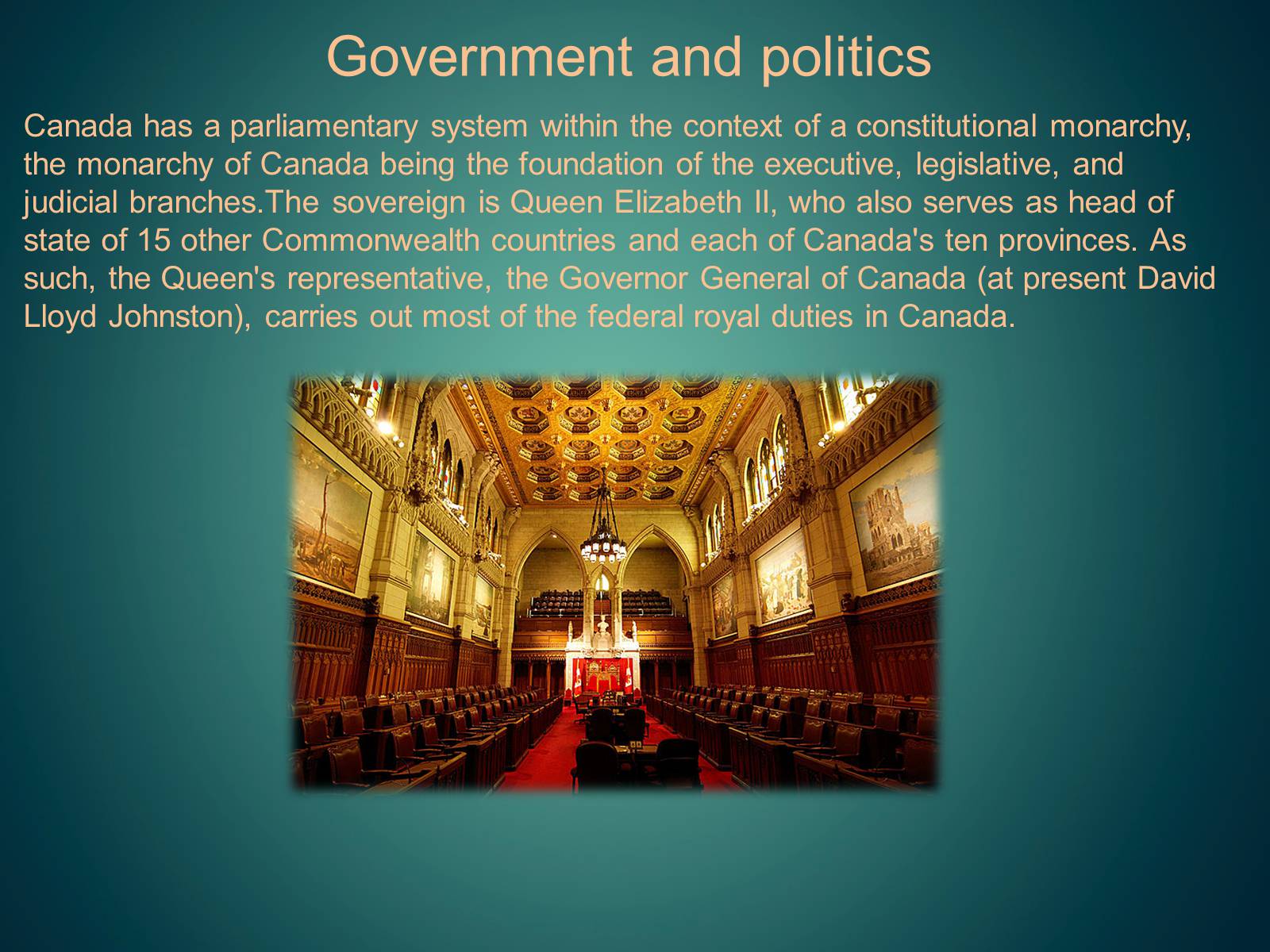
Слайд #6
International organizations
Canada is recognized as a middle power for its role in international affairs with a tendency to pursue multilateral solutions.As well as its membership of the United Nations, the World Trade Organization and the Organisation for Economic Co-operation and Development (OECD), Canada is a member of regional and other international organizations and forums for economic and culltural affairs.Canada acceded to the International Covenant on Civil and Political Rights in 1976.
Canada is recognized as a middle power for its role in international affairs with a tendency to pursue multilateral solutions.As well as its membership of the United Nations, the World Trade Organization and the Organisation for Economic Co-operation and Development (OECD), Canada is a member of regional and other international organizations and forums for economic and culltural affairs.Canada acceded to the International Covenant on Civil and Political Rights in 1976.
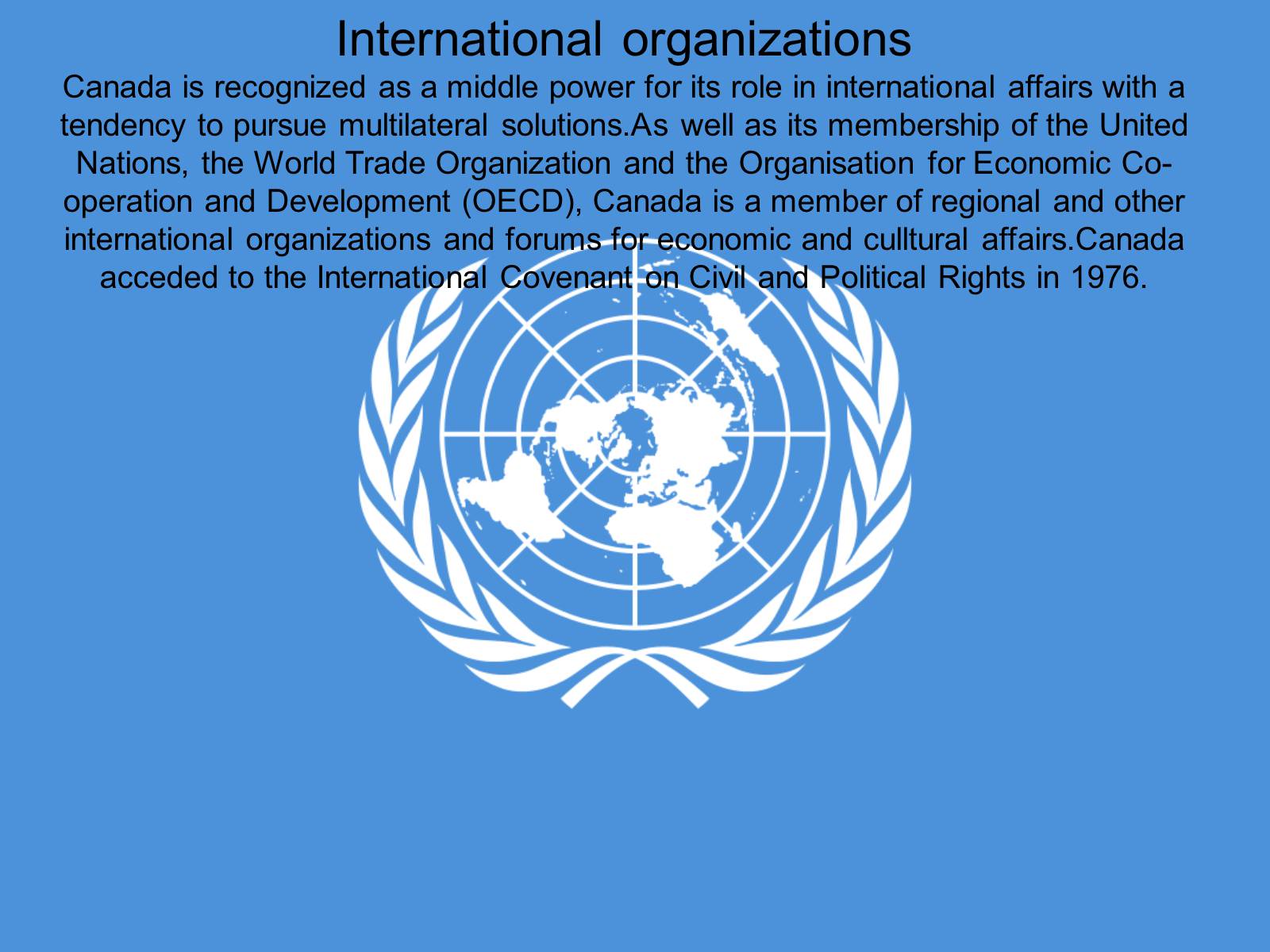
Слайд #7
Provinces and territories
Canada is a federation composed of ten provinces and three territories. In turn, these may be grouped into four main regions: Western Canada, Central Canada, Atlantic Canada, and Northern Canada. Provinces have more autonomy than territories, having responsibility for social programs such as health care, education, and welfare. Using its spending powers, the federal government can initiate national policies in provincial areas, such as the Canada Health Act; the provinces can opt out of these, but rarely do so in practice.
Canada is a federation composed of ten provinces and three territories. In turn, these may be grouped into four main regions: Western Canada, Central Canada, Atlantic Canada, and Northern Canada. Provinces have more autonomy than territories, having responsibility for social programs such as health care, education, and welfare. Using its spending powers, the federal government can initiate national policies in provincial areas, such as the Canada Health Act; the provinces can opt out of these, but rarely do so in practice.
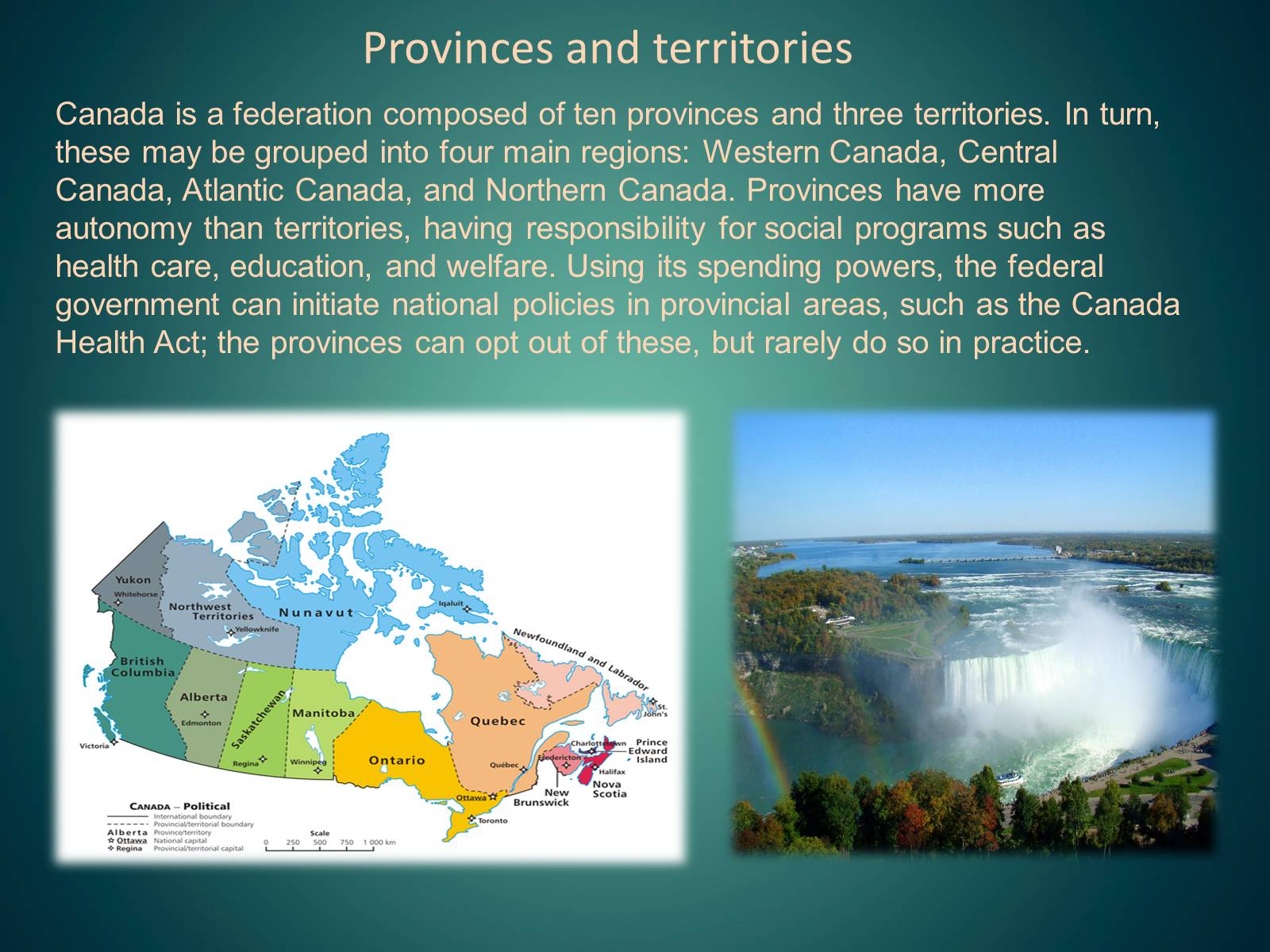
Слайд #8
Economy
Since the early 20th century, the growth of Canada's manufacturing, mining, and service sectors has transformed the nation from a largely rural economy to an urbanized, industrial one. Like many other developed nations, the Canadian economy is dominated by the service industry, which employs about three-quarters of the country's workforce.However, Canada is unusual among developed countries in the importance of its primary sector, in which the logging and petroleum industries are two of the most prominent components.
Since the early 20th century, the growth of Canada's manufacturing, mining, and service sectors has transformed the nation from a largely rural economy to an urbanized, industrial one. Like many other developed nations, the Canadian economy is dominated by the service industry, which employs about three-quarters of the country's workforce.However, Canada is unusual among developed countries in the importance of its primary sector, in which the logging and petroleum industries are two of the most prominent components.
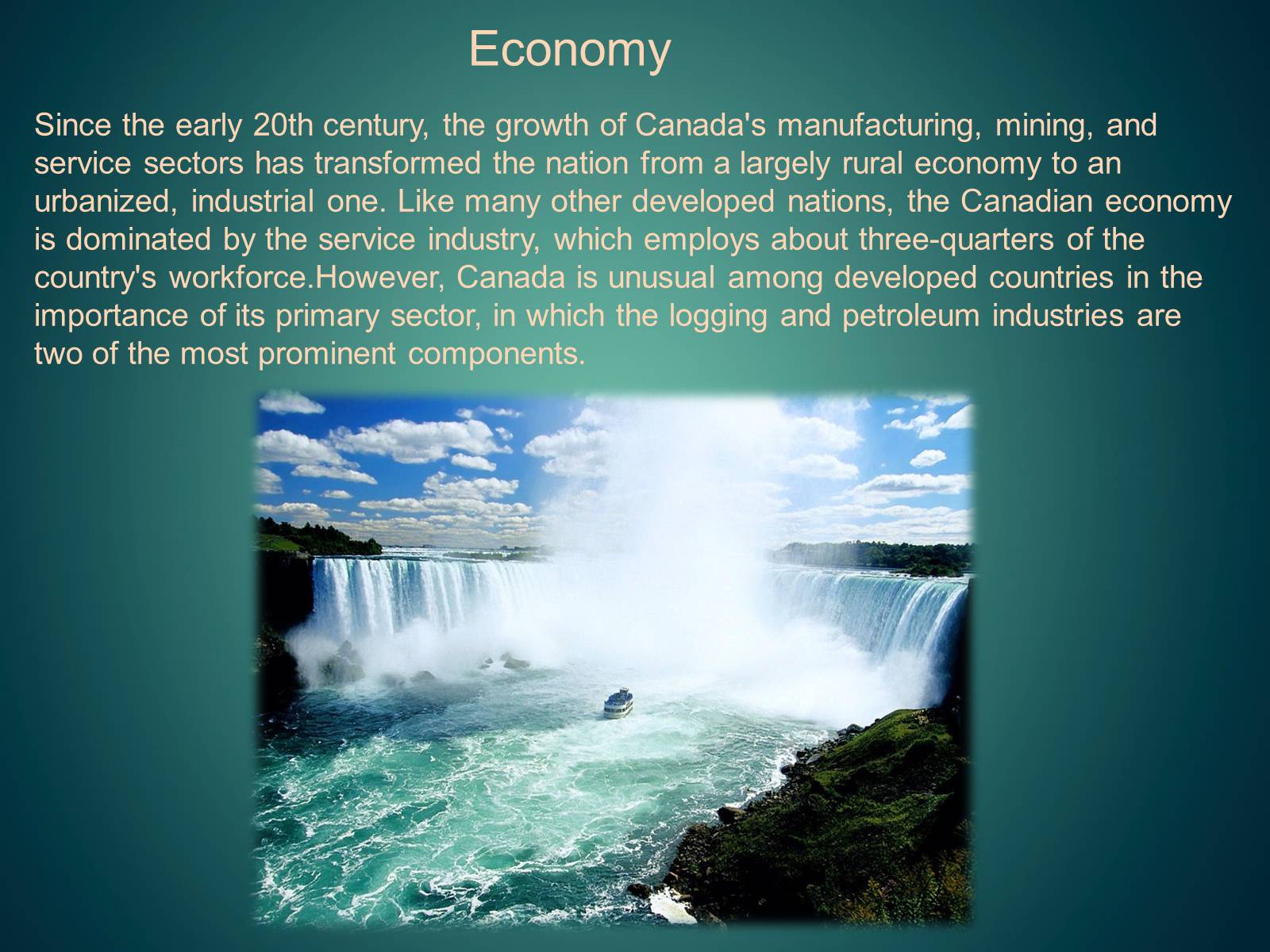
Слайд #9
Atlantic Canada possesses vast offshore deposits of natural gas, and Alberta also hosts large oil and gas resources. The vastness of the Athabasca oil sands and other assets results in Canada having 13% of the global oil reserves, the world's third-largest, after Venezuela and Saudi Arabia.Canada is additionally one of the world's largest suppliers of agricultural products; the Canadian Prairies are one of the most important global producers of wheat, canola, and other grains.The Ministry of Natural Resources in Canada provides statistics regarding their major exports, zinc and uranium, and is a leading exporter of many other minerals, such as gold, nickel, aluminum, steel, iron ore, Coking Coal, and lead.
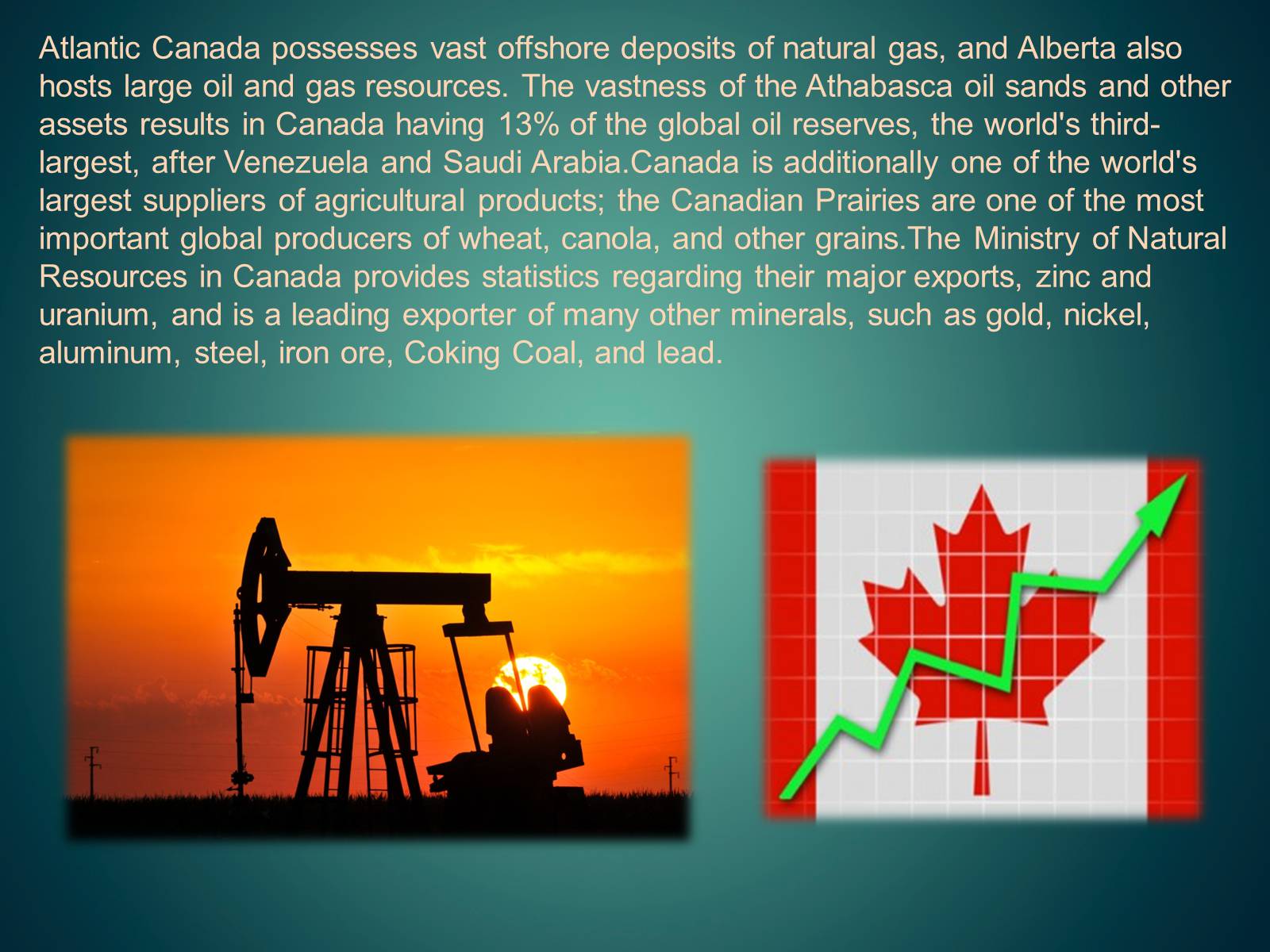
Слайд #10
Demographics
The 2011 Canadian census counted a total population of 33,476,688, an increase of around 5.9 percent over the 2006 figure.By December 2012, Statistics Canada reported a population of over 35 million, signifying the fastest growth rate of any G8 nation.Between 1990 and 2008, the population increased by 5.6 million, equivalent to 20.4 percent overall growth. The main drivers of population growth are immigration and, to a lesser extent, natural growth.
The 2011 Canadian census counted a total population of 33,476,688, an increase of around 5.9 percent over the 2006 figure.By December 2012, Statistics Canada reported a population of over 35 million, signifying the fastest growth rate of any G8 nation.Between 1990 and 2008, the population increased by 5.6 million, equivalent to 20.4 percent overall growth. The main drivers of population growth are immigration and, to a lesser extent, natural growth.
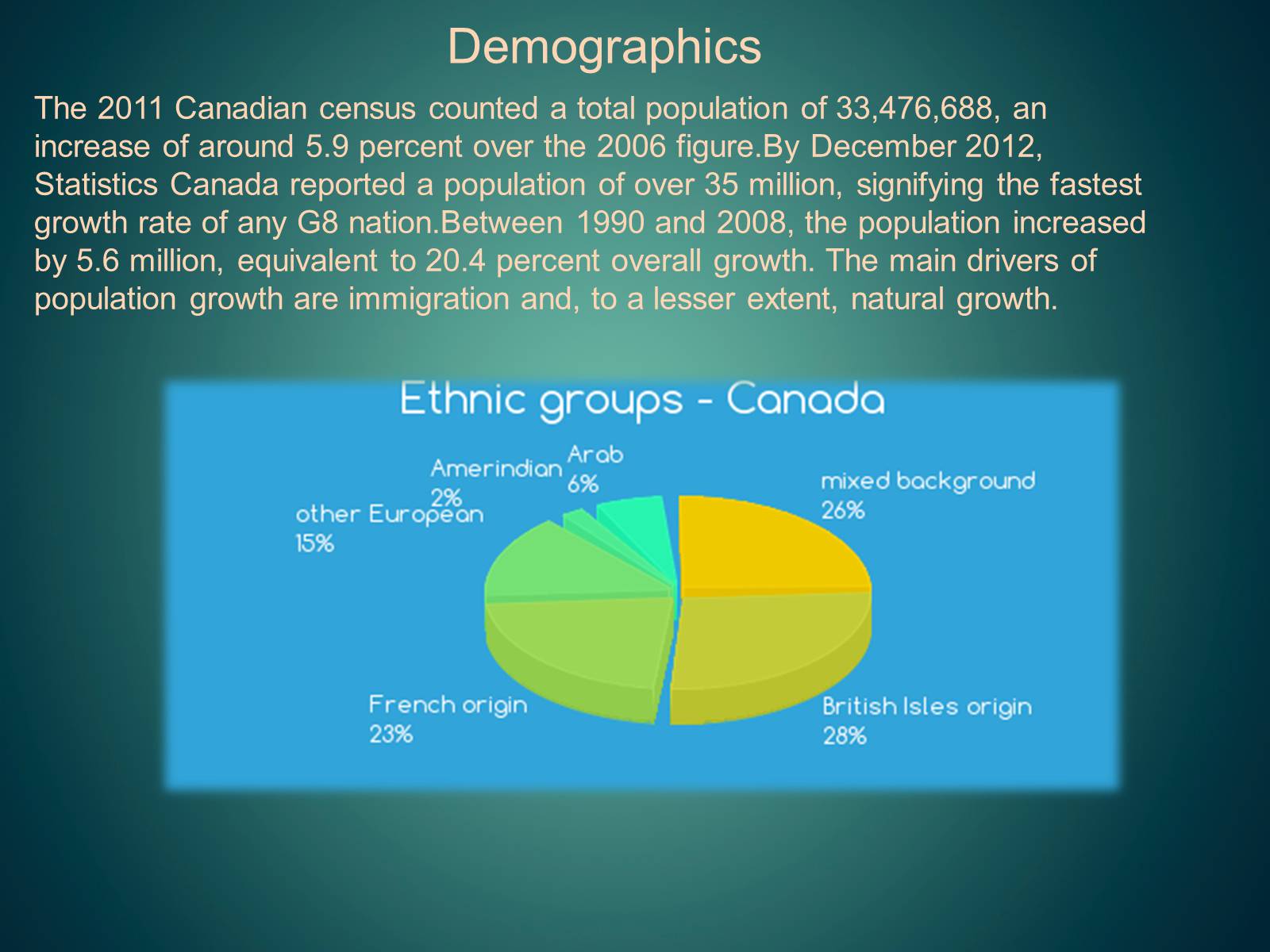
Слайд #11
According to the 2006 census, the country's largest self-reported ethnic origin is Canadian (accounting for 32% of the population), followed by English (21%), French (15.8%), Scottish (15.1%), Irish (13.9%), German (10.2%), Italian (4.6%), Chinese (4.3%), First Nations (4.0%), Ukrainian (3.9%), and Dutch (3.3%).There are 600 recognized First Nations governments or bands, encompassing a total of 1,172,790 people.
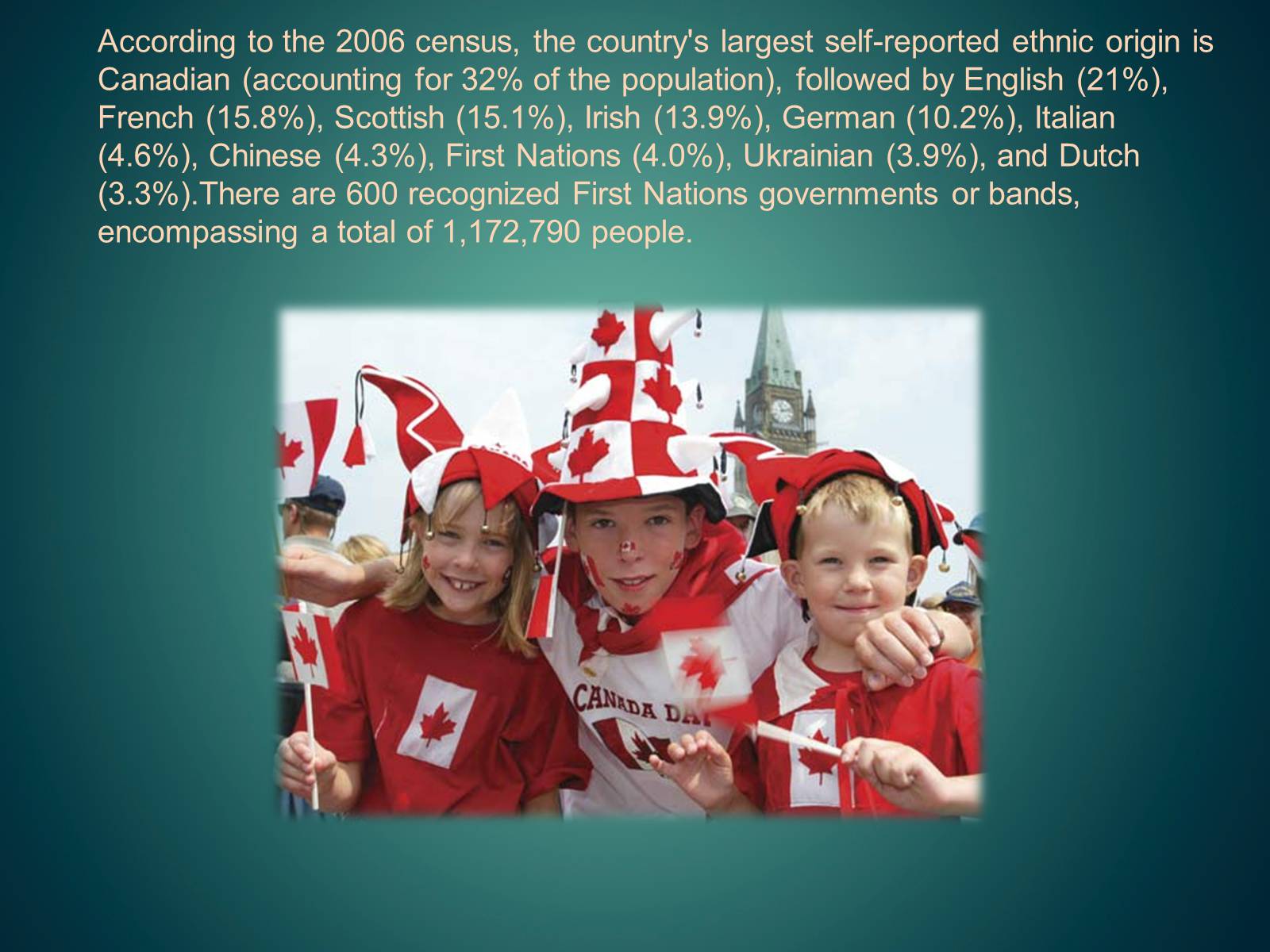
Слайд #12
Language
Canada's two official languages are English and French, pursuant to Section 16 of the Canadian Charter of Rights and Freedoms and the Federal Official Languages Act. Canada's federal government practices official bilingualism, which is applied by the Commissioner of Official Languages. English and French have equal status in federal courts, Parliament, and in all federal institutions. Citizens have the right, where there is sufficient demand, to receive federal government services in either English or French, and official-language minorities are guaranteed their own schools in all provinces and territories.
Canada's two official languages are English and French, pursuant to Section 16 of the Canadian Charter of Rights and Freedoms and the Federal Official Languages Act. Canada's federal government practices official bilingualism, which is applied by the Commissioner of Official Languages. English and French have equal status in federal courts, Parliament, and in all federal institutions. Citizens have the right, where there is sufficient demand, to receive federal government services in either English or French, and official-language minorities are guaranteed their own schools in all provinces and territories.
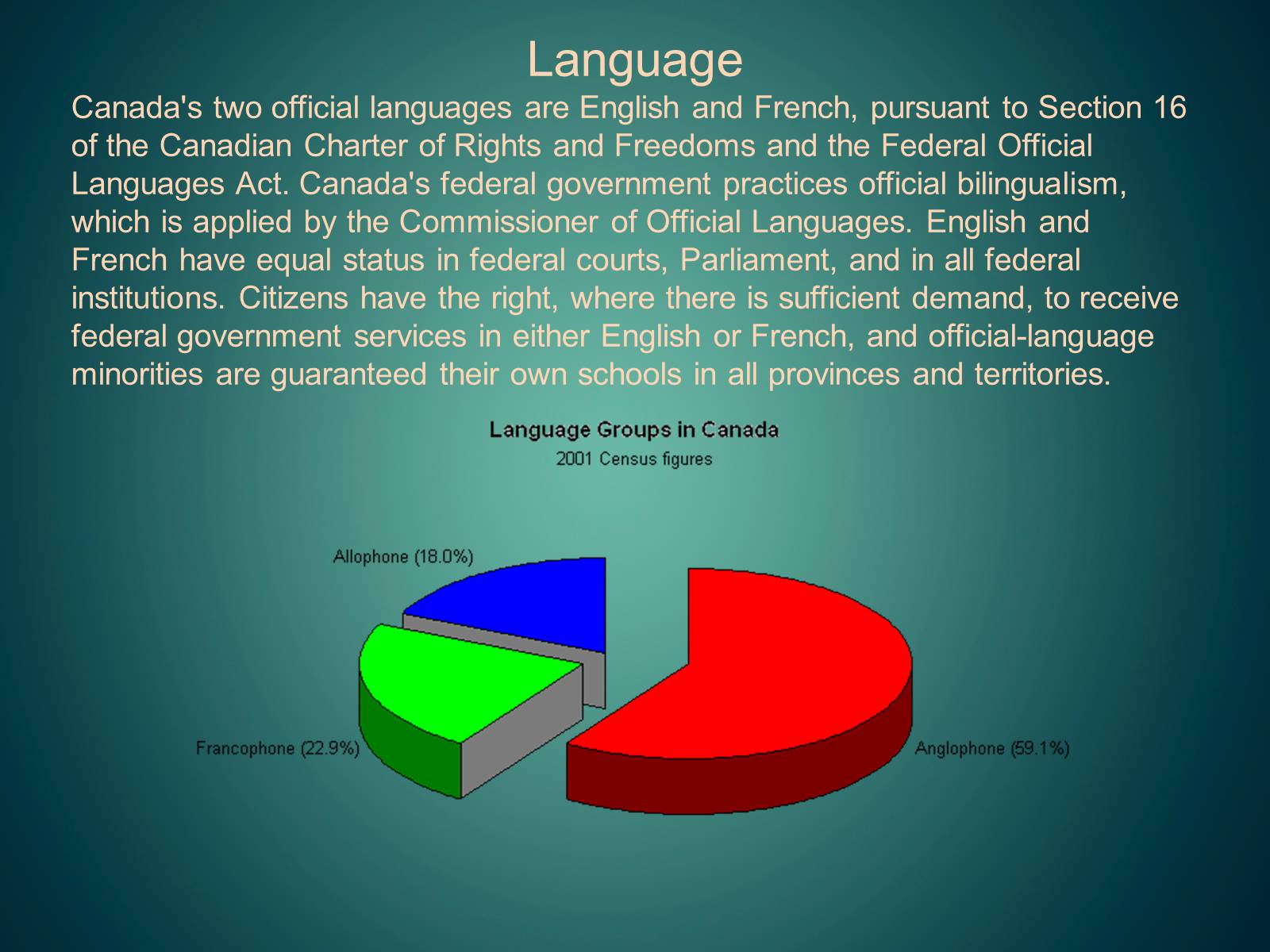
Слайд #13
In 2011, nearly 6.8 million Canadians listed a non-official language as their mother tongue.Some of the most common non-official first languages include Chinese (mainly Cantonese; 1,072,555 first-language speakers), Punjabi (430,705), Spanish (410,670), German (409,200), and Italian.
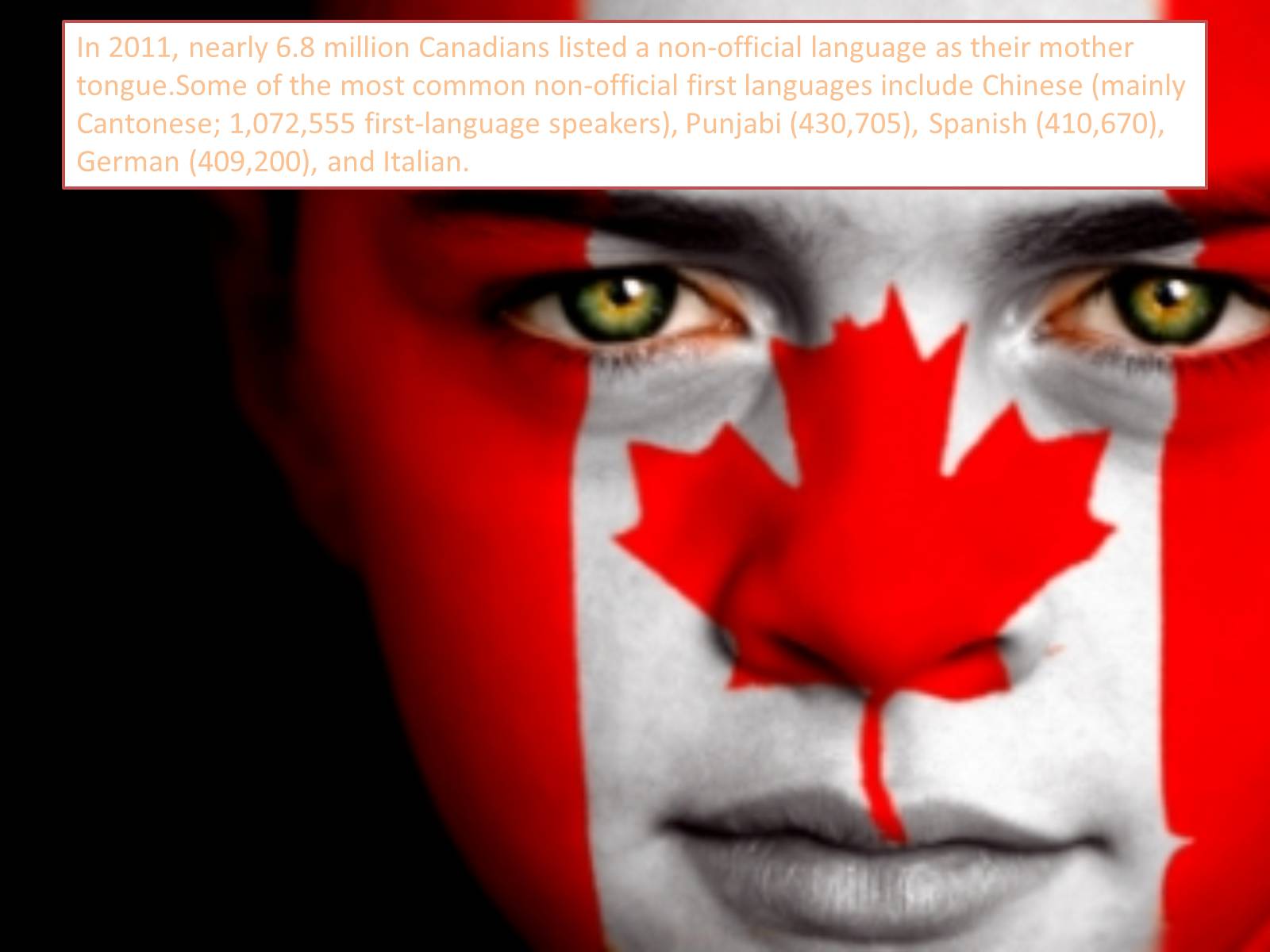
Слайд #14
Culture
Canada's culture draws influences from its broad range of constituent nationalities, and policies that promote multiculturalism are constitutionally protected. In Quebec, cultural identity is strong, and many French-speaking commentators speak of a culture of Quebec that is distinct from English Canadian culture.However, as a whole, Canada is in theory a cultural mosaic – a collection of several regional, aboriginal, and ethnic subcultures.Government policies such as publicly funded health care, higher taxation to redistribute wealth, the outlawing of capital punishment, strong efforts to eliminate poverty, strict gun control, and the legalization of same-sex marriage are further social indicators of Canada's political and cultural values.
Canada's culture draws influences from its broad range of constituent nationalities, and policies that promote multiculturalism are constitutionally protected. In Quebec, cultural identity is strong, and many French-speaking commentators speak of a culture of Quebec that is distinct from English Canadian culture.However, as a whole, Canada is in theory a cultural mosaic – a collection of several regional, aboriginal, and ethnic subcultures.Government policies such as publicly funded health care, higher taxation to redistribute wealth, the outlawing of capital punishment, strong efforts to eliminate poverty, strict gun control, and the legalization of same-sex marriage are further social indicators of Canada's political and cultural values.
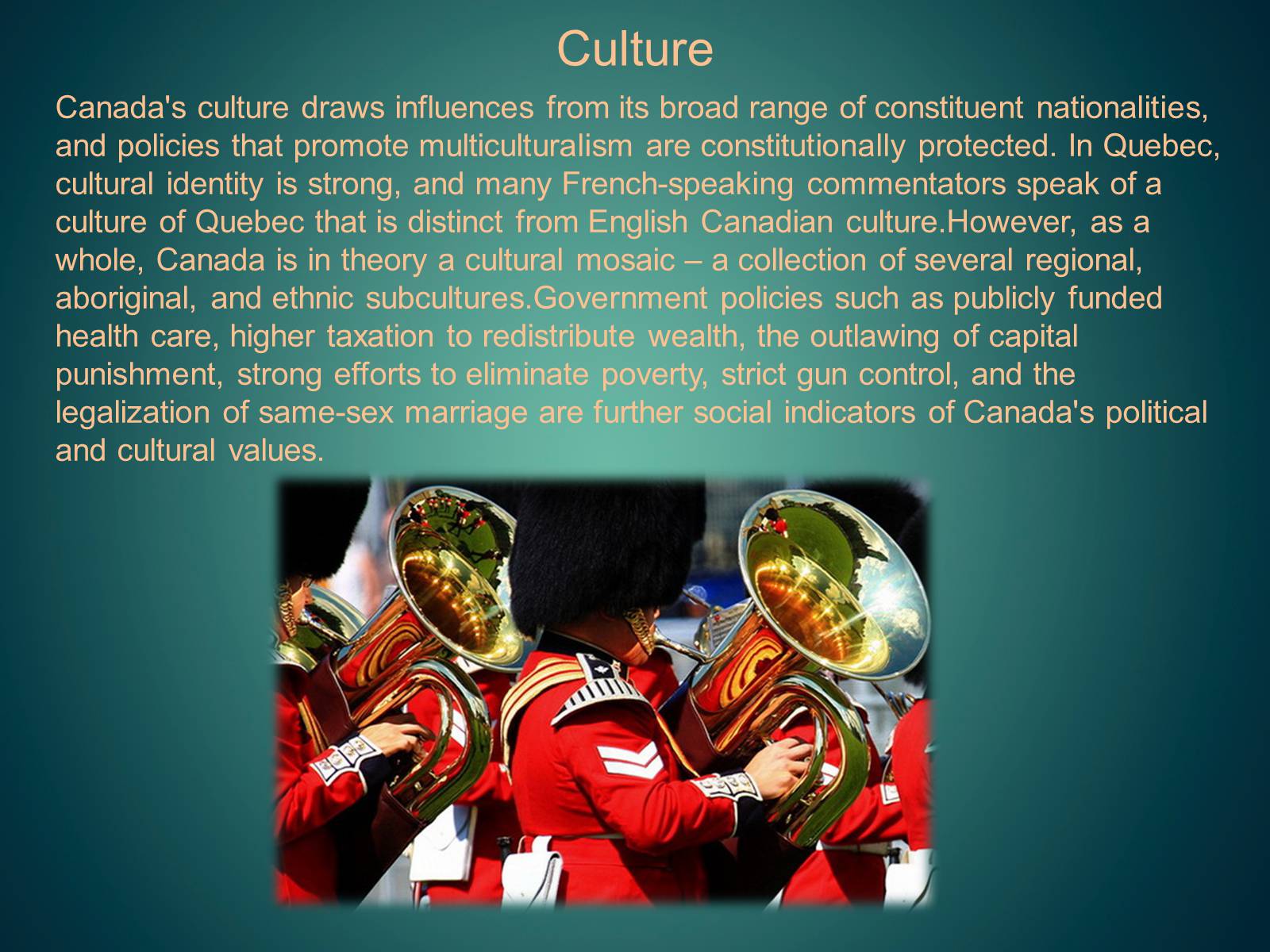
Слайд #15
Historically, Canada has been influenced by British, French, and aboriginal cultures and traditions. Through their language, art and music, aboriginal peoples continue to influence the Canadian identity.Many Canadians value multiculturalism and see Canada as being inherently multicultural.American media and entertainment are popular, if not dominant, in English Canada; conversely, many Canadian cultural products and entertainers are successful in the United States and worldwide.
